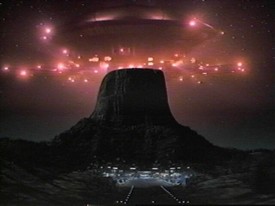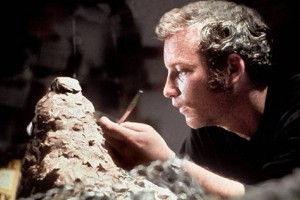UFOs and the Midlife Crisis
I’ve obviously been thinking a lot about UFOs in the last couple months—duh—so out of a sense of blogging duty I thought I should get out my DVD of Close Encounters and watch it again, and perhaps comment on it. It has been a couple years.
 I totally disagree with Spielberg’s overt premise—that ETs are gearing up for a great big contact event where they finally reveal themselves to us as wise and benevolent cosmic tricksters. But I still love pretty much everything about the film, and even confess to be moved by the typically sugary-happy Spielberg ending. It’s a wonderful, exciting, and at times awe-inspiring film.
I totally disagree with Spielberg’s overt premise—that ETs are gearing up for a great big contact event where they finally reveal themselves to us as wise and benevolent cosmic tricksters. But I still love pretty much everything about the film, and even confess to be moved by the typically sugary-happy Spielberg ending. It’s a wonderful, exciting, and at times awe-inspiring film.
My favorite way to interpret any sci-fi film is to squint my eyes and remove the sci-fi aspect, imagine the film without it. Squinting, I had always sort of seen Close Encounters being as much about art and the creative process as it is about alien visitors. Roy Neary’s UFO-induced “inspiration” and his subsequent idée-fixe about a tower in the desert leads him gradually to realize his vision in sculpture—a process that is exactly (well, minus the UFO part) like the process of creating any artwork like a painting or a film or a novel. Art is a process of getting inspired and driven to work through a creative problem, often at the expense of family and personal relationships; it never lets you go until you stand back, dirt all over your clothes and hair tousled, and, like God at the end of Creation, finally see the thing you’ve made as good.
This time the latter theme struck me even more forcefully, but I also realized that the art aspect is just part of a bigger theme that lurks underneath everything else in the film. What’s left, if you really squint your eyes at Close Encounters, is the story of a man’s midlife crisis in all its aspects—sometimes ugly, sometimes pathetic, but also heroic (and not just in a Joseph Campbell hero-journey way).
 At the start of the film, Roy Neary is a husband and father pulled in a million directions—four loud and unruly kids, a hectic and not-very-fulfilling job, a loving but conventional and occasionally shrill wife, and the growing gnawing ache that comes to a man when age and the first intimations of mortality first start creeping into his consciousness. It drives a man, even without his being aware of it, to seek something more, to grow in some new way. The stereotype is that men going through such crises buy sports cars and leave their wives for girls half their age. Usually it’s not quite so picturesque, but it’s still disruptive.
At the start of the film, Roy Neary is a husband and father pulled in a million directions—four loud and unruly kids, a hectic and not-very-fulfilling job, a loving but conventional and occasionally shrill wife, and the growing gnawing ache that comes to a man when age and the first intimations of mortality first start creeping into his consciousness. It drives a man, even without his being aware of it, to seek something more, to grow in some new way. The stereotype is that men going through such crises buy sports cars and leave their wives for girls half their age. Usually it’s not quite so picturesque, but it’s still disruptive.
A man often takes up new hobbies like art. Feeling drawn in different directions he may neglect his job or even run the risk of losing it. He becomes irritable and chafes at his family duties and feels increasingly alienated from his wife. He may become a jerk or asshole to her, and she may increasingly see him as a child, be embarrassed by him, and urge him to get help or suggest seeing a counselor together. They often get separated, at least for a time, while he works out his issues.
He may feel an urge to be alone and hit the open road. He may not have a full-on extramarital affair, but he often finds connection in some platonic relationship with a woman who somehow seems to understand him better than his wife does—who grasps and appreciates the new self he is vaguely struggling to become. All through this he will be feeling great psychic pain and be desperate to understand what is happening to him.
These things are exactly what Roy does in the film.
It’s a not-widely-remembered fact that it was Carl Jung who first identified the midlife crisis as a stage in development. And I was frankly stunned by what a Jungian film Close Encounters is. In fact, it goes right along with Jung’s views on UFOs too. Jung didn’t deny the likely physical reality of flying saucers, whatever they are and wherever they originate (and he was vocal on the need for governmental disclosure). But as a psychologist he was interested in the way UFOs are also a projection screen for the unconscious. He said they likely manifest themselves (or are especially noticed) at times when society feels great anxiety and is at some crossroads.
This response to societal anxiety is mirrored in the response to anxieties on the individual level. Those in the grip of crisis, feeling a drive to grow toward individuation and wholeness, dream of and notice in their lives recurrent symbols of that wholeness, typically in the form of circular shapes or mandalas. In our age, what fits the bill for that better than flying saucers? He developed his argument through the analysis of numerous dreams about UFOs his patients had had. (I’ve had a million of those dreams, and I’m no stranger to midlife crises…)
At the culmination of Spielberg’s film, Roy, aided by the similarly lost and seeking Jillian, reaches his destination—he finds the reality he was gropingly trying to learn about and express in his art hobby. Could Jung have come up with a better way to symbolize the end of a man’s midlife crisis than having him enter a giant mandala that has descended in the desert?
Here’s to all our crises ending so spectacularly.



